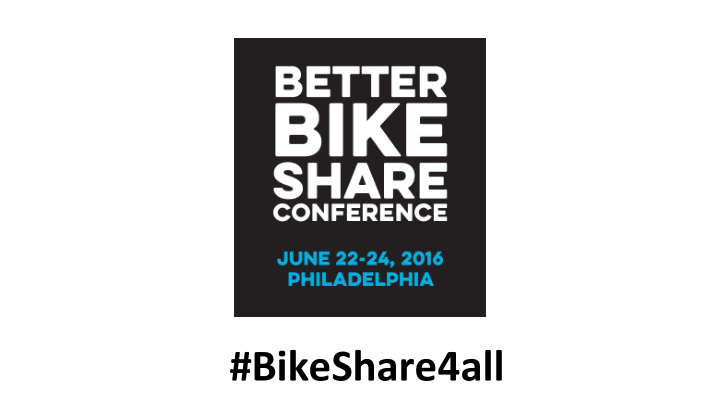



#BikeShare4all
Transforming Communities in the 21 st Century Connecting People to Opportunity
“ The choices we make about future transportation projects—the people and places they connect, will play ” a role in determining how widely opportunity expands throughout America. —Secretary Anthony R. Foxx
The U.S. Department of Transportation (DOT) plays a critical role in connecting Americans and communities to economic opportunity. Transportation infrastructure choices made at the Federal, State, and local levels can strengthen communities, create pathways to jobs, and improve the quality of life for all Americans. Transportation infrastructure can lift up neighborhoods and regions by attracting new opportunities, jobs, and housing. revitalize A multimodal transportation system provides Americans with safe, reliable, and affordable connections to employment, connect education, healthcare, and other essential services. Infrastructure investment creates jobs and paves the way for work business, particularly small and disadvantaged business enterprises.
Funding Projects that Promote Ladders of Opportunity The most recent rounds of Transportation Investment Generating Economic • Recovery [TIGER] Grants prioritized projects that strengthen access to opportunities through transportation improvements and promote Ladders of Opportunity, to the extent permitted by law. The Federal Transit Administration Bus & Bus Facilities “Ladders of Opportunity” • Initiative , awarded $100M to modernize and expand transit bus service to disadvantaged and low-income individuals, veterans, seniors, youths, and others to local workforce training, employment, health care, and other vital services.
Creating Pathways to a 21st Century Workforce The USDOT Local Hire Initiative makes it easier for states and cities to hire local residents for transportation projects. This initiative enables the Federal Transit Administration and Federal Highway Administration grantees to utilize contracting requirements and other labor hiring preferences such as geography and socioeconomic status so that local workers can participate in the rebuilding of their communities. The Crenshaw rail transit line will bring the people of this community to their jobs in other parts of the city and also bring jobs to the people of Crenshaw.
Many low-income and minority communities suffer from political disempowerment and historic underinvestment that has manifested in a lack of the basic infrastructure . 49% In high-income areas of low-income Low-income neighborhoods this number is almost neighborhoods 90% have more than double the have sidewalks fatality rate from traffic collisions as high-income neighborhoods. Source: Gibbs K, BTG Research Brief. University of Illinois at Chicago, 2012. www.bridgingthegapresearch.org
Safer People, Safer Streets Pedestrian and Bicycle Safety Initiative Identifying and removing barriers to improve safety. • Mayors' Challenge for Safer People, Safer Streets , a call to action for city officials to advance safety and accessibility goals. • Provides framework for action around seven Challenge Activities • Convenes webinars, calls, and summits for participants • 245 communities in 46 states have signed on • Road Safety Assessments, USDOT convened State, regional, and local transportation officials and stakeholders for on-the-ground safety assessments in every state.
USDOT Commits to Inclusive Networks • New Design, Data & Policy Resources: – Connected networks case studies – Design guide synthesis & gap identification • Fewer required criteria on low-speed NHS highways • Level of Service guidance encourages multi-modal approach to reducing congestion • Ped-Bike improvements eligible for transit funds • Encouragement of Complete Streets policy implementation • Coming soon: – Strategic Agenda for Pedestrian and Bicycle Transportation – Pursuing Equity in Pedestrian & Bicycle Planning – FTA non-motorized access guidance
Innovative Finance for the 21 st Century A New Formula for Infrastructure Investment
Our infrastructure is aging. Many parts of it were built NEARLY 60 YEARS AGO With 70 million more people 65% more trucks on the road and 45% more freight in the next 30 years WE HAVE NO CHOICE BUT TO BUILD NEW INFRASTRUCTURE
Connecting People to Opportunity – A Vision for Bridging the Divide – The challenge we face as a country is that we must reinvent how we think about transportation. We need to aspire to more, we need a transportation system that connects a big missing dot in the line between income inequality and opportunity. – Secretary Anthony R. Foxx Transportation connects people to opportunity and can invigorate opportunity within communities. T o the greatest extent possible, we should support transportation projects that do both. While we cannot change the past, we can ensure that current and future transportation projects connect and strengthen communities, including areas that have, in the past, been on the wrong side of transportation decisions. Transportation facilities should be built by, for and with the communities impacted by them. Development of transportation facilities should meaningfully reflect and incorporate the input of all the people and communities they touch.
#BikeShare4all
Recommend
More recommend